3.1: Why Study Organizational Theory
3.1.1: What is Organizational Behavior?
Organizational behavior is the field of study that investigates how organizational structures affect behavior within organizations.
Learning Objective
Define organizational behavior and the way in which computer modeling and systematic frameworks enable further study
Key Points
- Organizational behavior studies organizations from multiple viewpoints, including behavior within the organization and in relation to other organizations.
- Micro organizational behavior refers to individual and group dynamics in an organizational setting.
- Macro organizational theory studies whole organizations and industries, including how they adapt, and the strategies, structures, and contingencies that guide them.
- Concepts such as leadership, decision making, team building, motivation, and job satisfaction are all facets of organizational behavior and responsibilities of management.
- Organizational behavior also deals heavily in culture. Company or corporate culture is difficult to define but is extremely relevant to how organizations behave.
Key Term
- behavior
-
The way a living creature acts.
Definition of Organizational Behavior
Organizational behavior studies the impact individuals, groups, and structures have on human behavior within organizations. It is an interdisciplinary field that includes sociology, psychology, communication, and management. Organizational behavior complements organizational theory, which focuses on organizational and intra-organizational topics, and complements human-resource studies, which is more focused on everyday business practices.
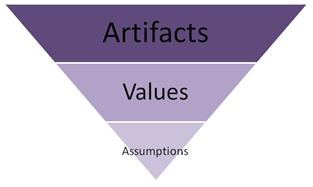
Behavior model
Diagram of Schein’s organizational behavior model, which depicts the three central components of an organization’s culture: artifacts (visual symbols such as office dress code), values (company goals and standards), and assumptions (implicit, unacknowledged standards or biases).
Different Types of Organizational Behavior
Organizational studies encompass the study of organizations from multiple perspectives, methods, and levels of analysis. “Micro” organizational behavior refers to individual and group dynamics in organizations. “Macro” strategic management and organizational theory studies whole organizations and industries, especially how they adapt, and the strategies, structures, and contingencies that guide them. Some scholars also include the categories of “meso”-scale structures, involving power, culture, and the networks of individuals in organizations, and “field”-level analysis, which studies how entire populations of organizations interact.
Many factors come into play whenever people interact in organizations. Modern organizational studies attempt to understand and model these factors. Organizational studies seek to control, predict, and explain. Organizational behavior can play a major role in organizational development, enhancing overall organizational performance, as well as also enhancing individual and group performance, satisfaction, and commitment.
Topics in Organizational Behavior
Organizational behavior is particularly relevant in the field of management due to the fact that it encompasses many of the issues managers face on a daily basis. Concepts such as leadership, decision making, team building, motivation, and job satisfaction are all facets of organizational behavior and responsibilities of management. Understanding not only how to delegate tasks and organize resources but also how to analyze behavior and motivate productivity is critical for success in management.
Organizational behavior also deals heavily in culture. Company or corporate culture is difficult to define but is extremely relevant to how organizations behave. A Wall Street stock-trading company, for example, will have a dramatically different work culture than an academic department at a university. Understanding and defining these work cultures and the behavioral implications they embed organizationally is also a central topic in organizational behavior.
3.1.2: Why Study Organizational Theory?
Organizational theory studies organizations to identify how they solve problems and how they maximize efficiency and productivity.
Learning Objective
Define the value and applications of organizational theory from a business perspective.
Key Points
- Correctly applying organizational theory can have several benefits for both the organization and society at large. Developments in organizations help boost economic potential in a society and help generate the tools necessary to fuel its capitalistic system.
- Once an organization sees a window for expansion, it begins to grow and thus alters the economic equilibrium by catapulting itself forward. This expansion induces changes not only in the organization’s infrastructure but also in competing organizations and the economy as a whole.
- One example of how development in organizational theory improves efficiency is in factory production. Henry Ford created the assembly line, a system of organization that enabled efficiency and drove both Ford and the U.S. economy forward.
Key Terms
- efficiency
-
The extent to which a resource, such as electricity, is used for the intended purpose; the ratio of useful work to energy expended.
- normative
-
Of, pertaining to, or using a standard.
Definition of Organizational Theory
Organizational theory studies organizations to identify the patterns and structures they use to solve problems, maximize efficiency and productivity, and meet the expectations of stakeholders. Organizational theory then uses these patterns to formulate normative theories of how organizations function best. Therefore, organizational theory can be used in order to learn the best ways to run an organization or identify organizations that are managed in such a way that they are likely to be successful.
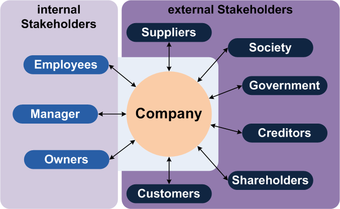
Organizational theory and stakeholders
Organizational theory examines patterns in meeting stakeholders’ needs. This concept map illustrates common internal and external stakeholders: internal stakeholders include employees and managers, while external stakeholders include customers, suppliers, creditors, and society at large. A company must take all of these stakeholders’ interests into account.
Organizational Theory
Correctly applying organizational theory can have several benefits for both the organization and society at large. As many organizations strive to integrate themselves into capitalistic societies, they initiate a ripple effect between other competing firms and already-existing economic pressures. Once an organization sees a window for expansion, it begins to grow by producing more and thus alters the economic equilibrium by catapulting itself forward into a new environment of production. This expansion induces changes not only in the organization’s infrastructure but also in competing organizations and the economy as a whole. Other firms observe these innovative developments and recreate them efficiently. Developments in organizations help boost economic potential in a society and help generate the tools necessary to fuel its capitalistic system.
One example of how development in an organization affects the modern era is through factory production. The concept of factory production amplified production as a whole and allowed for the organized division of labor to start. It centralized facets of the workforce and began to define the rules of production and trade, which also led to specialization. Henry Ford implemented an innovative design by modifying factory production and creating the assembly line, which is still used in many factories in contemporary society. These developments make it easier for a company to produce and thus incentivize firms to aggregate and utilize more efficient methods for running their companies.
Organizational theory can also help identify malicious forms of corporate practice and use them to highlight future precautionary measures. The nuclear accident at Three Mile Island helped determine ways to ensure the prevention of similar incidents. In that case, developments in organizational theory led to stronger government regulations and stronger production-related safety mandates.
3.2: Classical Perspectives
3.2.1: Classical Versus Behavioral Perspectives
The classical perspective focuses on direct inputs to efficiency, while the behavioral perspective examines indirect inputs too.
Learning Objective
Compare and contrast the central concepts that define a classical organizational-theory approach and a behavioral perspective.
Key Points
- The classical perspective of management emerged from the Industrial Revolution and focuses on the efficiency, productivity, and output of employees as well as of the organization as a whole. It generally does not focus on human or behavioral attributes or variation among employees.
- The classical perspective of management is often criticized for ignoring human desires and needs in the workplace and does not take into consideration human error in work performance. The classical perspective has strong influences on modern operations and process improvement.
- The behavioral perspective of management (sometimes called the “human relations perspective”) takes a much different approach from the classical perspective: it is generally more concerned with employee well-being and encourages management approaches that consider the employee as a motivated worker who genuinely wants to work.
Key Terms
- micromanage
-
To rely on extreme supervision and close monitoring of employee work.
- psychosocial
-
Related to one’s psychological development in, and interaction with, a social environment.
The Classical Perspective of Management
The classical perspective of management, which emerged from the Industrial Revolution, focuses on improving the efficiency, productivity, and output of employees, as well as the business as a whole. However, it generally does not focus on human or behavioral attributes or variances among employees, such as how job satisfaction improves employee efficiency.
Frederick Winslow Taylor
Scientific management theory, which was first introduced by Frederick Winslow Taylor, focused on production efficiency and productivity of employees. By managing production efficiency as a science, Taylor thought that worker productivity could be completely controlled. He used the scientific method of measurement to create guidelines for the training and management of employees. This quantitative, efficiency-based approach is representative of the classical perspective.
Max Weber
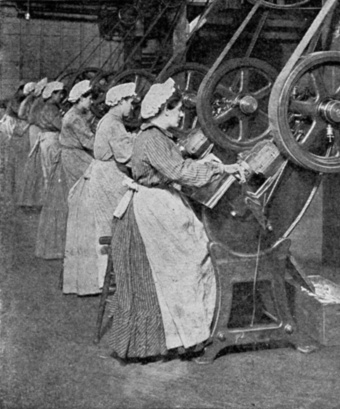
Classical Perspective of Management
The classical perspective of management focused on improving worker productivity.
Another leader in the classical perspective of management, Max Weber, created the bureaucracy theory of management, which focuses on the theme of rationalization, rules, and expertise for an organization as a whole. Weber’s theory also focuses on efficiency and clear roles in an organization, meaning that management in organizations should run as effectively as possible with as little bureaucracy as possible. One example of Weber’s management theory is the modern “flat” organization, which promotes as few managerial levels as possible between management and employees.
Henri Fayol
Henri Fayol, another leader in classical management theory, also focused on the efficiency of workers, but he looked at it from a managerial perspective—i.e., he focused on improving management efficiency rather than on improving each individual employee’s efficiency. Fayol created six functions of management, which are now taught as the following four essential functions of management: planning, organizing, leading, and controlling.
The classical perspective of management theory pulls largely from these three theorists (Taylor, Weber, and Fayol) and focuses on the efficiency of employees and on improving an organization’s productivity through quantitative (i.e., measurable, data-driven) methods. The classical perspective is often criticized for ignoring human desires and needs in the workplace and typically does not take into consideration human error in work performance. The classical perspective has strong influences on modern operations and process improvement, which uses quantitative metrics to determine how effectively a process is running.
The Behavioral Perspective of Management
The behavioral perspective of management (sometimes called the “human relations perspective”) takes a much different approach from the classical perspective. It began in the 1920s with theorists such as Elton Mayo, Abraham Maslow, and Mary Parker Follett.
The Hawthorne Studies
The Hawthorne studies were an important start to the behavioral perspective of management. These were a series of research studies conducted with the workers at the Hawthorne plant of the Western Electric Company. The Hawthorne studies found that workers were more strongly motivated by psychosocial factors than by economic or financial incentives.
Abraham Maslow
Around this same time, Abraham Maslow created his hierarchy-of-needs theory, which showed that workers were motivated through a series of lower-level to higher-level needs. This theory has been applied in the workplace to better understand “soft” factors of employee motivation, such as goal setting and team involvement, in order to better manage employees.
Douglas McGregor
Additional theories in the behavioral perspective include Douglas McGregor’s Theory X and Theory Y, which have to do with the perceptions managers have about their employees and how employees react to those perceptions. In Theory X, managers assume employees are inherently lazy and, therefore, micromanage. In Theory Y, managers are more laissez-faire and allow employees more freedom in their work. McGregor’s theory of management is an example of how behavior-management theory looks more into the “human” factors of management and encourages managers to understand how psychological characteristics can improve or hinder employee performance.
Generally, the behavioral perspective is much more concerned with employee well-being and encourages management approaches that consider the employee as a motivated worker who wants to work and wants to produce quality work. This theory therefore encourages a management approach that is less focused on micromanaging and is more focused on building relationships with employees in order to help them achieve their workplace goals and work as effectively and efficiently as possible.
3.2.2: Scientific Management: Taylor and the Gilbreths
Scientific management focuses on improving efficiency and output through scientific studies of workers’ processes.
Learning Objective
Differentiate between Taylorism and the Gilbreths’ perspective on the one hand and motion studies on scientific management on the other
Key Points
- Scientific management, or Taylorism, is a management theory that analyzes work flows to improve economic efficiency, especially labor productivity. This management theory, developed by Frederick Winslow Taylor, was dominant in manufacturing industries in the 1880s and 1890s.
- Important components of scientific management include analysis, synthesis, logic, rationality, empiricism, work ethic, efficiency, elimination of waste, and standardized best practices.
- Taylor and the Gilbreths introduced methods of measuring worker productivity, including time studies and motion studies, which are still used today in operations and management.
Key Terms
- Scientific Management
-
An early 20th-century theory that analyzed workflows in order to improve efficiency.
- Time studies
-
Created by Frederick Winslow Taylor, these break down each job into component parts and time each part to determine the most efficient method of working.
- Taylorism
-
Scientific management; an early 20th-century theory of management that analyzed workflows in order to improve efficiency.
- Motion Study
-
Created by Frank and Lillian Gilbreth, these analyzed work motions by filming workers and emphasized areas for efficiency improvement by reducing motion.
Taylorism
Scientific management, or Taylorism, is a management theory that analyzes work flows to improve economic efficiency, especially labor productivity. This management theory, developed by Frederick Winslow Taylor, was popular in the 1880s and 1890s in manufacturing industries.
While the terms “scientific management” and “Taylorism” are often treated as synonymous, an alternative view considers Taylorism to be the first form of scientific management. Taylorism is sometimes called the “classical perspective,” meaning that it is still observed for its influence but no longer practiced exclusively. Scientific management was best known from 1910 to 1920, but in the 1920s, competing management theories and methods emerged, rendering scientific management largely obsolete by the 1930s. However, many of the themes of scientific management are still seen in industrial engineering and management today.
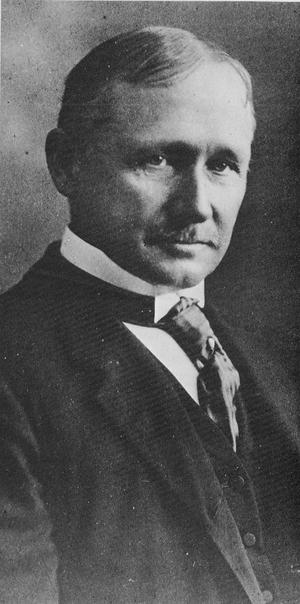
Frederick Winslow Taylor
Frederick Winslow Taylor is considered the creator of scientific management.
Important components of scientific management include analysis, synthesis, logic, rationality, empiricism, work ethic, efficiency, elimination of waste, and standardized best practices. All of these components focus on the efficiency of the worker and not on any specific behavioral qualities or variations among workers.
Today, an example of scientific management would be determining the amount of time it takes workers to complete a specific task and determining ways to decrease this amount of time by eliminating any potential waste in the workers’ process. A significant part of Taylorism was time studies. Taylor was concerned with reducing process time and worked with factory managers on scientific time studies. At its most basic level, time studies involve breaking down each job into component parts, timing each element, and rearranging the parts into the most efficient method of working. By counting and calculating, Taylor sought to transform management into a set of calculated and written techniques.
Frank and Lillian Gilbreth
While Taylor was conducting his time studies, Frank and Lillian Gilbreth were completing their own work in motion studies to further scientific management. The Gilbreths made use of scientific insights to develop a study method based on the analysis of work motions, consisting in part of filming the details of a worker’s activities while recording the time it took to complete those activities. The films helped to create a visual record of how work was completed, and emphasized areas for improvement. Secondly, the films also served the purpose of training workers about the best way to perform their work.
This method allowed the Gilbreths to build on the best elements of the work flows and create a standardized best practice. Time and motion studies are used together to achieve rational and reasonable results and find the best practice for implementing new work methods. While Taylor’s work is often associated with that of the Gilbreths, there is often a clear philosophical divide between the two scientific-management theories. Taylor was focused on reducing process time, while the Gilbreths tried to make the overall process more efficient by reducing the motions involved. They saw their approach as more concerned with workers’ welfare than Taylorism, in which workers were less relevant than profit. This difference led to a personal rift between Taylor and the Gilbreths, which, after Taylor’s death, turned into a feud between the Gilbreths and Taylor’s followers.
Even though scientific management was considered background in the 1930s, it continues to make significant contributions to management theory today. With the advancement of statistical methods used in scientific management, quality assurance and quality control began in the 1920s and 1930s. During the 1940s and 1950s, scientific management evolved into operations management, operations research, and management cybernetics. In the 1980s, total quality management became widely popular, and in the 1990s “re-engineering” became increasingly popular. One could validly argue that Taylorism sent the groundwork for these large and influential fields we practice today.
3.2.3: Bureaucratic Organizations: Weber
Weber’s bureaucracy focused on creating rules and regulations to simplify complex procedures in societies and workplaces.
Learning Objective
Define bureaucratic organization, as theorized by the German sociologist Max Weber
Key Points
- Max Weber was a member of the classical school of management, and his writing contributed to the field’s scientific school of thought. He wrote about the importance of bureaucracy in society.
- Weberian bureaucracy is characterized by hierarchical organization, action taken on the basis of (and recorded in) written rules, and bureaucratic officials requiring expert training. Career advancement depends on technical qualifications judged by an organization, not individuals.
- Weber’s ideas on bureaucracy stemmed from society during the Industrial Revolution. As Weber understood it, society was being driven by the passage of rational ideas into culture, which, in turn, transformed society into an increasingly bureaucratic entity.
Key Terms
- bureaucratic control
-
Setting standards, measuring actual performance, and taking corrective action through administrative or hierarchical techniques such as creating policies.
- iron cage
-
Weber’s theory that a bureaucratic society would result in a situation in which it would be impossible to avoid bureaucracy and thus society would become increasingly more rational.
- bureaucracy
-
A complex means of managing life in social institutions that includes rules and regulations, patterns, and procedures that are designed to simplify the functioning of complex organizations.
Max Weber was a German sociologist, political economist, and administrative scholar who contributed to the study of bureaucracy and administrative literature during the late 1800s and early 1900s. Weber was a member of the classical school of management, and his writing contributed to the field’s scientific school of thought. Weber’s ideas on bureaucracy stemmed from society during the Industrial Revolution. As Weber understood it, particularly during the Industrial Revolution of the late nineteenth century, society was being driven by the passage of rational ideas into culture, which, in turn, transformed society into an increasingly bureaucratic entity.
Bureaucracy Defined
Bureaucracy is a complex means of managing life in social institutions that includes rules and regulations, patterns, and procedures that are designed to simplify the functioning of complex organizations. An example of bureaucracy would be the forms used to pay income taxes. Specific information and procedures are required to fill them out. Included in those forms, however, are countless rules and laws that dictate what can and cannot be included. Bureaucracy simplifies the process of paying taxes by putting the process into a formulaic structure, but simultaneously complicates the process by adding rules and regulations.

IRS tax form
An IRS tax form is an example of a complex form.
Bureaucracy in the Workplace
Weber’s theories on bureaucracy included topics such as specialization of the work force, the merit system, standardized principles, and structure and hierarchy in the workplace. In his writings, Weber focused on the idea of a bureaucracy, which differs from a traditional managerial organization because workers are judged by impersonal, rule-based activity and promotion is based on merit and performance rather than on immeasurable qualities. Weberian bureaucracy is also characterized by hierarchical organization, delineated lines of authority in a fixed area of activity, action taken on the basis of (and recorded in) written rules, and bureaucratic officials requiring expert training. In a bureaucracy, career advancement depends on technical qualifications judged by an organization, not individuals. Weber’s studies of bureaucracy contributed to classical management theory by suggesting that clear guidelines and authority need to be set in order encourage an effective workplace. Weber did not see any alternative to bureaucracy and predicted that this would lead to an “iron cage,” or a situation in which people would not be able to avoid bureaucracy, and society would thus become increasingly more rational. Weber viewed this as a bleak outcome that would affect individuals’ happiness as they would be forced to function in a highly rational society with rigid rules and norms without the possibility to change it. Of course, due to the advent of the behavior-management movement in the 1920s, this bleak situation did not come to pass.
3.2.4: Administrative Management: Fayol’s Principles
Fayol’s approach differed from scientific management in that it focused on efficiency through management training and behavioral characteristics.
Learning Objective
Outline Fayol’s effect on administrative management through the recognition of his 14 management principles
Key Points
- Fayol took a top-down approach to management by focusing on managerial practices to increase efficiency in organizations. His writing provided guidance to managers on how to accomplish their managerial duties and on the practices in which they should engage.
- The major difference between Fayol and Taylor is Fayol’s concern with the “human” and behavioral characterisitcs of employees and his focus on training management instead of on individual worker efficiency.
- Fayol stressed the importance and the practice of forecasting and planning in order to train management and improve workplace productivity.
- Fayol is also famous for putting forward 14 principles of management and the five elements that constitute managerial responsibilities.
Key Terms
- Fayolism
-
An approach that focused on managerial practices that could minimize misunderstandings and increase efficiency in organizations.
- top-down
-
Of or relating to a perspective that progresses from a single, large basic unit to multiple, smaller subunits.
Henri Fayol
Fayol was a classical management theorist, widely regarded as the father of modern operational-management theory. His ideas are a fundamental part of modern management concepts.
Comparisons with Taylorism
Fayol is often compared to Frederick Winslow Taylor, who developed scientific management. However, Fayol differed from Taylor in his focus and developed his ideas independently. Taylor was concerned with task time and improving worker efficiency, while Fayol was concerned with management and the human and behavioral factors in management.
Another major difference between Taylor and Fayol’s theories is that Taylor viewed management improvements as happening from the bottom up, or starting with the most elemental units of activity and making individual workers more efficient. In contrast, Fayol emphasized a more top-down perspective that was focused on educating management on improving processes first and then moving to workers. Fayol believed that by focusing on managerial practices organizations could minimize misunderstandings and increase efficiency.
His writings guided managers on how to accomplish their managerial duties and on the practices in which they should engage. In his book “General and Industrial Management” Fayol outlined his theory of general management, which he believed could be applied to the administration of myriad industries. As a result of his concern for workers, Fayol was considered one of the early fathers of the human relations movement.
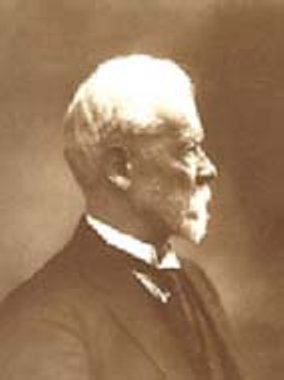
Henri Fayol
Henri Fayol pioneered definitions of control for management science.
Fayol’s 14 Principles of Management
Fayol developed 14 principles of management in order to help managers conduct their affairs more effectively. Today, these principles are still used but are often interpreted differently. The fourteen principles are as follows:
1. division of work
2. delegation of authority
3. discipline
4. chain of commands
5. congenial workplace
6. interrelation between individual interests and common organizational goals
7. compensation package
8. centralization
9. scalar chains
10. order
11. equity
12. job guarantee
13. initiatives
14. team spirit
Fayol’s Five Elements of Management
Fayol is also famous for his five elements of management, which outline the key responsibilities of good managers:
- Planning: Managers should draft strategies and objectives to determine the stages of the plan and the technology necessary to implement it.
- Organizing: Managers must organize and provide the resources necessary to execute said plan, including raw materials, tools, capital, and human resources.
- Command (delegation): Managers must utilize authority and a thorough understanding of long-term goals to delegate tasks and make decisions for the betterment of the organization.
- Coordination: High-level managers must work to integrate all activities to facilitate organizational success. Communication is key to success in this component.
- Monitoring: Managers must compare the activities of the personnel to the plan of action; this is the evaluation component of management.
3.2.5: Flaws in the Classical Perspectives
The classical approach to management is often criticized for viewing a worker as a mere tool to improve efficiency.
Learning Objective
Assess the comprehensive arguments underlining the flaws in utilizing classical organizational theory perspectives, primarily Taylorism and the scientific method
Key Points
- Under Taylorism, the work effort of workers increased in intensity, but eventually workers became dissatisfied with the work environment and became angry, decreasing overall work ethic and productivity.
- Taylorism’s negative effects on worker morale only added fuel to the fire of existing labor-management conflict and inevitably contributed to the strengthening of labor unions.
- The criticisms of classical management theory opened doors for theorists such as George Elton Mayo and Abraham Maslow, who emphasized the human and behavioral aspects of management.
- The scientific management approach is also lacking when applied to larger, more operationally complex organizations. Managerial efficacy and the empowerment of employees are more important to overall productivity when tasks are not simple and homogeneous.
Key Term
- Taylorism
-
Scientific management; a theory of management of the early 20th century that analyzed workflows in order to improve efficiency.
The Downside of Efficiency
The classical view of management tends to focus on the efficiency and productivity of workers rather than on workers’ human needs. Generally the classical view is associated with Taylorism and scientific management, which are largely criticized for viewing the worker as more of a gear in the machine than an individual. Under Taylorism the work effort of workers increased in intensity, but eventually workers became dissatisfied with the work environment and became angry, which affected their overall work ethic. This dissatisfaction undoes the value captured via increased efficiency.
Taylorism’s negative effects on worker morale only added fuel to the fire of existing labor-management conflict, which frequently raged out of control between the mid-19th and mid-20th centuries (when Taylorism was most influential), and thus it inevitably contributed to the strengthening of labor unions. That outcome neutralized most or all of the benefit of any productivity gains that Taylorism had achieved. The net benefit to owners and management ended up being small or negative. It would take new efforts, borrowing some ideas from Taylorism but mixing them with others, to produce more successful formulas.

Factory workers
Taylorism and classical management styles negatively affected the morale of workers, which created a negative relationship between workers and managers.
Scientific management also led to other pressures tending toward worker unhappiness. Offshoring and automation are two such pressures that have led to the erosion of employment. Both were made possible by the deskilling of jobs, which arose because of the knowledge transfer that scientific management achieved, whereby knowledge was transferred to cheaper workers, as well as from workers into tools.
The Human Factor
To summarize, the underlying weakness of the classical view of management is the omission of the fact that employees are people first and resources second. This criticism opened doors for theorists such as George Elton Mayo and Abraham Maslow, who emphasized the human and behavioral aspects of management. After all, what value is wealth if the individual loses the sense of self-worth and happiness required to enjoy it? The behavioral approach to management took an entirely different approach and focused on managing morale, leadership, and other behavioral factors to encourage productivity rather than solely managing the time and efficiency of workers.
Corporate Growth
Another disadvantage of the classical perspective arises from the growing size and complexity of the modern organization. Using metrics to examine specific employee behavior may be feasible in a smaller organization pursuing homoegeneous tasks, but it becomes more difficult when trying to accomplish this at an organization that has hundreds of employees pursuing various complex functions. In this situation, it may be more beneficial to use tactics that are less focused on the individual employee and more on improving overall productivity. This will involve less micromanaging and more trusting employees to do the right thing while at the workplace. The onus of enabling efficiency, therefore, shifts from workers to managers.
3.3: Behavioral Perspectives
3.3.1: The Behavioral-Science Approach
Behavioral science uses research and the scientific method to determine and understand behavior in the workplace.
Learning Objective
Define the behavioral approaches which maximize potential within a company or organization
Key Points
- Behavioral science draws from a number of different fields and theories, primarily those of psychology, social neuroscience, and cognitive science.
- One application of the behavioral-science approach can be seen in a field called organizational development. Organizational development is an ongoing, systematic process of implementing effective organizational change.
- Behavioral sciences include relational sciences, which deal with relationships, interaction, communication networks, associations, and relational strategies.
- Combined, the behavioral science approach is broadly about understanding individual and group behavioral dynamics to initiate meaningful organizational development.
Key Term
- organizational development
-
An ongoing, systematic process of implementing effective organizational change using theories from behavioral sciences.
Behavioral science draws from a number of different fields and theories, primarily those of psychology, social neuroscience, and cognitive science. Behavioral science uses research and the scientific method to determine and understand behavior in the workplace. Many of the theories in the behavioral perspective are included in the behavioral-science approach to management. For example, the Hawthorne studies used the scientific method and are considered to be a part of the behavioral-science approach.
Behavioral science within the business management environment is a specific application of this field, and employs a number of specific types of behavioral observations. This includes concepts such as information processing, relationships and motivation, and organizational development.
Information Processing
Information processing involves determining how people process stimuli in their environment. This field deals with the processing of stimuli from the social environment by cognitive entities in order to engage in decision making, social judgment, and social perception. The field is particularly concerned with information processing as it relates to individual functioning and the survival of an organism in a social environment.
Relationships
Behavioral sciences also include relational sciences that deal with relationships, interaction, communication networks, associations, and relational strategies or dynamics between organisms or cognitive entities in a social system. The emphasis on using quantitative data and qualitative research methods to determine how people process information and understand social relationships is important to helping managers better understand the proven methods for increasing employee motivation and employee productivity. The behavioral-science approach and the myriad of fields it encompasses is the most common study of management science today.
Organizational Development
The primary application of the behavioral-science approach can be seen in the field of organizational development. Organizational development is an ongoing, systematic process of implementing effective organizational change. Organizational development is considered both a field of applied behavioral science that focuses on understanding and managing organizational change as well as a field of scientific study and inquiry. It uses components of behavioral sciences and studies in the fields of sociology, psychology, and theories of motivation, learning, and personality to implement effective organizational change and aid in the development of employees.
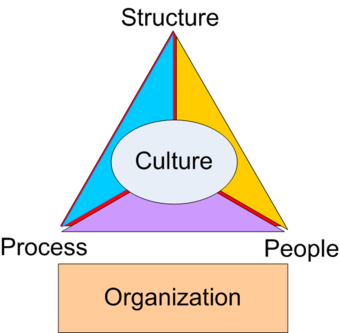
Organization triangle
This diagram illustrates the idea that structure, process, and the people involved all play a role in an organization’s culture.
Combined, the behavioral-science approach is broadly about understanding individual and group behavioral dynamics to initiate meaningful organizational development. The study of human behavior in the context of organizational change is an integral part of empowering organizations to grow, adapt, and learn to capture competitive advantage.
3.3.2: Behaviorism: Follett, Munsterberg, and Mayo
Behaviorism initiated a focus on the psychological and human factors influencing workers.
Learning Objective
Compare and contrast the three most famous pioneers and founders of the behavioral perspective in organizational theory
Key Points
- Mary Parker Follett, Hugo Munsterberg, and Elton Mayo are all considered pioneers and founders of the behaviorism movement in management theory. They wrote about the importance of considering behavioral aspects of workers in addition to the efficiency of workers.
- Mary Parker Follett (September 3, 1868 – December 18, 1933) was an American social worker, management consultant, and pioneer in the fields of organizational theory and organizational behavior.
- Hugo Munsterberg was one of the pioneers of applied psychology, extending his research and theories to industrial/organizational (I/O), legal, medical, clinical, educational, and business settings.
- Elton Mayo is known as the founder of the human relations movement. His research includes the Hawthorne studies and his book The Human Problems of an Industrialized Civilization.
Key Term
- Industrial Psychology
-
A field focusing on topics such as hiring workers with personalities and mental abilities best suited to certain types of vocations.
Mary Parker Follett, Hugo Munsterberg, and Elton Mayo are all considered pioneers and founders of the industrial/organizational psychology and behaviorism movements in management theory. These three individuals wrote about the importance of considering behavioral aspects of workers in addition to the efficiency of workers. This was, in many ways, a continuation of the scientific method, with the critical difference of incorporating the human factors involved in effective management.
Follett
Mary Parker Follett (September 3, 1868 – December 18, 1933) was an American social worker, management consultant, and pioneer in the fields of organizational theory and organizational behavior. She criticized the overmanagement of employees, a process now known as micromanaging. Follett was known for the concept of reciprocal relationships and the idea that authority is inferior to integrative collaboration. Managers should enable, not dictate.
She also distinguished herself in the field of management by being sought out by President Theodore Roosevelt as his personal consultant on managing not-for-profit, non-governmental, and voluntary organizations. In her capacity as a management theorist, Mary Parker Follett pioneered the understanding of lateral processes within hierarchical organizations. Her contributions aided the beginning of the behaviorism movement of management by presenting the worker as more than just a machine.
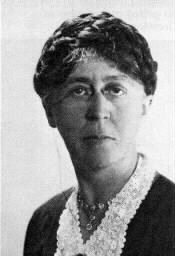
Mary Parker Follett
Mary Parker Follett defined management as “the art of getting things done through people.”
Munsterberg
Hugo Munsterberg (June 1, 1863 – December 19, 1916) was a German-American psychologist. He was one of the pioneers of applied psychology, extending his research and theories to industrial/organizational (I/O), legal, medical, clinical, educational, and business settings. Munsterberg’s writings are considered the genesis of the field of industrial psychology.
Industrial psychology, according to Munsterberg, focuses on topics such as hiring workers with personalities and mental abilities best suited to certain types of vocations, as well as on ways to increase motivation, performance, and retention. Munsterberg suggests that psychology could be used in many different industrial applications, including management, vocational decisions, advertising, job performance, and employee motivation. Many of Munsterberg’s ideas, especially the idea of matching an individual’s personality with the correct job set and skills, are common in the use of industrial/organizational psychology today.
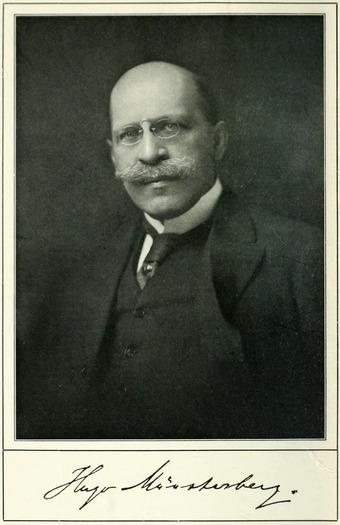
Hugo Munsterberg
Munsterberg is considered the father of industrial/organizational psychology.
Mayo
George Elton Mayo (December 26, 1880 – September 7, 1949) was an Australian psychologist, sociologist, and organization theorist. Mayo is known as the founder of the human relations movement. His research includes the Hawthorne studies and his book The Human Problems of an Industrialized Civilization (1933).
The research he conducted in the Hawthorne studies of the 1930s showed the importance of groups in affecting the behavior of individuals at work. Mayo’s employees Roethlisberger and Dickson conducted the practical experiments. This enabled him to make certain deductions about how managers should behave. He concluded that people’s work performance is dependent on both social issues and job content. He suggested a tension between workers’ “logic of sentiment” and managers’ “logic of cost and efficiency” that could lead to conflict within organizations. Mayo’s studies contributed to the behaviorism movement in management as managers became more aware of the “soft” skills that are important to successful management.
Follett, Munsterberg, and Mayo each introduced important components and ideas into the behaviorism perspective of management. They all believed that successful management comes from understanding how to best treat and motivate employees in order to help them succeed in their jobs and become as efficient as possible.
3.3.3: The Human Side: Hawthorne
The Hawthorne studies found that workers were more responsive to group involvement and managerial attention than to financial incentives.
Learning Objective
Evaluate Mayo and Roethlisberger’s Hawthorne study relative to the behavioral perspective in organizational theories
Key Points
- The Hawthorne studies, which were conducted by Elton Mayo and Fritz Roethlisberger in the 1920s with the workers at the Hawthorne plant of the Western Electric Company, were part of an emphasis on socio-psychological aspects of human behavior in organizations.
- Hawthorne researchers hypothesized that choosing one’s own coworkers, working as a group, being treated as special (as evidenced by working in a separate room), and having a sympathetic supervisor were reasons for increases in worker productivity.
- The Hawthorne studies found that monetary incentives and good working conditions are generally less important in improving employee productivity than meeting employees’ need and desire to belong to a group and be included in decision making and work.
Key Term
- Hawthorne studies
-
A series of investigations conducted in the 1920s emphasizing the socio-psychological aspects of human behavior in organizations.
The Hawthorne studies were conducted with the workers at the Hawthorne plant of the Western Electric Company by Elton Mayo and Fritz Roethlisberger in the 1920s. The Hawthorne studies were part of a refocus on managerial strategy incorporating the socio-psychological aspects of human behavior in organizations.

Western Electric Company, the location of the Hawthorne studies
This is where the studies where conducted—a factory outside of Chicago.
The studies suggested that employees have social and psychological needs—along with economic and financial needs—which must be met in order to be motivated to complete their assigned tasks. The human relations movement is concerned with morale, leadership, and factors that aid in the cooperation of workers.
This theory of management was a byproduct of the issues that arose from the classical, scientific perspectives on management (i.e., Taylorism). The simplest explanation of the hypothesis being investigated is quite intuitive. Employees (i.e. human resources) are not merely motivated by financial gain, and productivity is not simply a byproduct of incentives and optimized working spaces. People are motivated by inclusion, constructive feedback, interest, autonomy, and a wide variety of other ‘soft’ factors (i.e. factors aside from money and other tangible resources).
Results of the Hawthorne Studies
The studies originally looked into whether workers were more responsive and worked more efficiently under certain environmental conditions, such as improved lighting. The results were surprising, as Mayo and Roethlisberger found that workers were more responsive to social factors—such as the people they worked with on a team and the amount of interest their manager had in their work—than the factors (lighting, etc.) the researchers had gone in to inspect.
The Hawthorne studies helped conclude that workers were highly responsive to additional attention from their managers and the feeling that their managers actually cared about, and were interested in, their work. The studies also concluded that although financial motives are important, social factors are equally important in defining the worker productivity.
There were a number of other experiments conducted in the Hawthorne studies, including one in which two women were chosen as test subjects and were then asked to choose four other workers to join the test group. Together, the women worked assembling telephone relays in a separate room over the course of five years (1927–1932), and their output was measured.
The measuring began in secret. It started two weeks before moving the women to an experiment room and continued throughout the study. In the experiment room, they had a supervisor who discussed changes with them and, at times, used their suggestions. The researchers then spent five years measuring how different variables impacted both the group’s and the individuals’ productivity. Some of the variables included giving two five-minute breaks (after a discussion with the group on the best length of time), and then changing to two 10-minute breaks (not the preference of the group).
Intangible Motivators
Changing a variable usually increased productivity, even if the variable was just a change back to the original condition. Researchers concluded that the employees worked harder because they thought they were being monitored individually. Researchers hypothesized that choosing one’s own coworkers, working as a group, being treated as special (as evidenced by working in a separate room), and having a sympathetic supervisor were the real reasons for the productivity increase.
The Hawthorne studies showed that people’s work performance is dependent on social issues and job satisfaction, and that monetary incentives and good working conditions are generally less important in improving employee productivity than meeting individuals’ need and desire to belong to a group and be included in decision making and work.
3.3.4: Managerial Assumption: McGregor
McGregor introduced Theories X and Y, which summarize and compare the classical management and behavioral management perspectives.
Learning Objective
Explain Douglas McGregor’s Theory X and Theory Y approach, merging classical and behavioral organizational theories
Key Points
- Douglas McGregor was a management professor at the MIT Sloan School of Management. He wrote a book in 1960 called The Human Side of Management, which suggested motivating employees through authoritative direction and employee self-control, respectively called Theory X and Theory Y.
- Theory X, based more on classical management theory, assumes that workers need a high amount of supervision because people are inherently lazy. It assumes that managers need to motivate through coercion and punishment.
- Theory Y assumes that employees are ambitious, self-motivated, exercise self-control, and generally enjoy mental and physical work duties. Theory Y is in line with behavioral management theories.
- Theories X and Y relate to Maslow’s hierarchy of needs in that they see human behavior and motivation as the main priority in maximizing output in the workplace.
Key Terms
- Theory Y
-
Postulates that employees are capable of being ambitious and self-motivated under suitable conditions; contrasted with Theory X.
- Theory X
-
Suggests that employees are inherently lazy and irresponsible and will tend to avoid work unless closely supervised and given incentives; contrasted with Theory Y.
Douglas McGregor was a management professor at the MIT Sloan School of Management. He wrote a book in 1960 called The Human Side of Management, which suggested motivating employees through authoritative direction and employee self-control. McGregor’s book was voted the fourth most influential management book of the 20th century in a poll of the Fellows of the Academy of Management.
McGregor’s main theory is comprised of Theory X and Theory Y. Theory X, based more on classical management theory, assumes that workers need a high amount of supervision because people are inherently lazy. Theory Y assumes that employees are ambitious, self-motivated, exercise self-control, and generally enjoy mental and physical work duties. Theory Y is in line with behavioral management theories. Often, managers’ actions toward their employees are affected by the theory to which they subscribe.
Theory X
In Theory X, managers tend to micro-manage and closely supervise employees. Complex hierarchical structures are needed in order to offer a narrow span of control at every level of the organization. Employees show little ambition without an incentive program and avoid responsibility whenever possible. Managers in Theory X rely more heavily on punishment, fear, and coercion as motivational techniques and less on reward. Managers and employees in this theory are generally mistrusted and they do not have rewarding relationships. Usually these managers believe that the sole purpose of the employee’s interest in the job is money.
Theory Y
Theory Y managers are generally the opposite. They believe that given the proper conditions, employees will learn to seek out and accept responsibility and to exercise self-direction in accomplishing objectives, that most people will want to do well at work, and that the satisfaction of doing a good job will be a strong motivation. Many people interpret Theory Y as a positive set of beliefs about workers.
McGregor thinks that Theory Y managers are more likely than Theory X managers to develop the climate of trust with employees that is required for human-resource development. This type of human-resource development is much more similar to the behavioral management theories of Maslow’s self-actualization and the Hawthorne studies than any of the classical theories of management.
Theory X or Theory Y?
Theories X and Y relate to Maslow’s hierarchy of needs in that they see human behavior and motivation as the main priority in maximizing output in the workplace. Both McGregor and Maslow would say that in order to help employees achieve maximum efficiency and happiness with their work, a Theory Y manager would need to promote morality, creativity, problem solving, and a lack of prejudice. McGregor was a lifetime proponent of Theory Y.
Modern organizations in developed countries generally side with McGregor, in that they believe Theory Y is superior in getting positive results from employees (and subsequently job satisfaction for employees). However, both theories are still prominent in the workplace, where many managers treat their employees as if they are lazy and likely to perform poorly without stringent rules and supervision. In management, just as everywhere else, it is difficult to effect social change in the face of human nature, even when the benefits are established.
3.3.5: Productivity: Argyris
Argyris’s theory of single- and double-loop learning has been applied to management theory to suggest the best ways for employees to learn.
Learning Objective
Identify Chris Argyris’s key contributions to organizational theory through single-loop and double-loop learning
Key Points
- Argyris studied how humans design and decide on their actions under difficult or stressful situations. He believed that human actions are controlled by environmental variables, which determine the key differences between single-loop learning and double-loop learning.
- In single-loop learning, individuals, groups, or organizations modify their actions according to the difference between expected and obtained outcomes.
- In double-loop learning, individuals, groups, or organizations question the values, assumptions, and policies that led to the actions in the first place.
- Argyris’s theory of single- and double-loop learning has been applied to management theory in order to suggest the best way for employees to learn and think about new goals and strategies for an organization.
Key Terms
- single-loop learning
-
A theory that says individuals, groups, or organizations modify their actions according to the difference between expected and obtained outcomes.
- learning organization
-
A company that facilitates the learning of its members and continuously transforms itself.
- double-loop learning
-
A theory in which an organization or individual questions the values, assumptions, and policies that led to a given situation.
Chris Argyris is an American business theorist, a professor emeritus at Harvard Business School, and a thought leader at Monitor Group. He is best known for his work on learning theories in the area of learning organizations.
Argyris conducted a series of research studies in action science, which studies how humans design and decide on their actions under difficult or stressful situations. Argyris believed that human actions are controlled by environmental variables, which determine the key differences between single-loop and double-loop learning.
Single-Loop Learning
In single-loop learning, entities (such as individuals, groups, or organizations) modify their actions according to the difference between expected and obtained outcomes. This essentially means that learning is through experience and direct reflection on outcomes, where the ends are justifying the means and dictating the fulcrum of the discussion and learning outcomes.
In many ways, this is a more reactionary approach. Individuals are tasked with identifying successes and failures, pursuing formulas for the former and minimizing the latter. While this type of learning, and this broader type of behavior, is extremely common in the real world, it is not the ideal method to learn and adapt from a broader organizational level. It tends to be simple and short-term, which is not always conducive to sustainability.
Double-Loop Learning
In double-loop learning, the entities question the values, assumptions, and policies that led to the actions in the first place; if they are able to view and modify those values, then second-order or double-loop learning has taken place. This is a more integrative, process-oriented, and collaborative approach. It is also much more complex, difficult, and sensitive, as the core values and strategies in place must be analyzed, questioned, and defended (or discarded).
The simple truth is that people fear change, actively avoid conflict, and generally preserve the status quo. Double-loop learning requires the bravery to challenge what is established organizationally, identify broader systemic issues, and fix problems at the source.

Single- and double-loop learning
Argyris wrote about the theories of single- and double-loop learning, which determine how people make decisions in difficult situations.
For example, a company that is facing a problem with its management strategy may decide to focus on how to improve or implement the strategy in different ways. In this situation, the company uses single-loop learning because management is focused on making changes without reconsidering the fundamental standard or strategy itself. However, if the company were to entirely reconsider the problematic strategy and start from scratch, this would constitute double-loop learning. Double-loop learning may lead to a change in the original strategy or goals that the company had in the first place.
Argyris’s theory of single- and double-loop learning has been applied to management theory in order to suggest the best way for employees to learn and think about new goals and strategies for an organization.
3.4: Modern Thinking
3.4.1: Quantitative and Analytical Management Tools
Quantitative tools are used by management to determine where a company is doing well or struggling compared to the industry and competitors.
Learning Objective
Give examples of quantitative and analytical management tools that assist organizations in better understanding workflow, financials and employee efficiency
Key Points
- Many quantitative and analytic tools are available for managers to better understand workflow processes, financial management, and employee efficiency.
- A decision tree is a decision support tool that uses a tree-like graph or model of decisions and their possible consequences, including chance event outcomes, resource costs, and utility.
- Simulation is the imitation of a real-world process or system over time.
- Trend charts are often used in management to display data over time to explore any potential trends, either positive or negative, that require additional attention by management. It is important to use statistical confidence intervals when utilizing this type of forecast.
- Benchmarking allows a manager to see how different aspects of a business are performing compared to national, regional, and industry standards. It also allows management to explore how the company is performing compared to its competitors.
- Financial projections and net-present-value (NPV) analyses are also commonplace when deciding upon new operations quantitatively—where the company predicts profitability in today’s dollars.
Key Terms
- benchmarking
-
A technique that allows a manager to compare metrics, such as quality, time, and cost, across an industry and against competitors.
- decision tree
-
A visualization of a complex decision-making situation in which the possible decisions and their likely outcomes are organized in the form of a graph that resembles a tree.
Managers can use many different quantitative and analytic tools to better understand workflow processes, financial management, and employee efficiency. These tools, such as decision tress, simulation, trend charts, benchmarking, and financial projections, help managers improve their decision-making abilities, determine how the business is performing relative to competitors, and discover opportunities for improvement. Using these tools to create quantitative and measurable metrics helps an organization see exactly where it is performing well and where it is performing poorly.
Types of Quantitative Tools
Decision Tree
A decision tree is a branching graph or model of decisions and their possible consequences, including chance event outcomes, resource costs, and utility. Decision trees are commonly used in operations research (specifically in decision analysis) to help identify a strategy most likely to reach a specified goal. They can also be used to map out a thought process or the possible consequences of a decision. A manager may use this tool when deciding between different projects or investments.

Decision tree
Decision trees are used to determine the consequences and potential outcomes of an investment or a project. This decision tree shows the money lost or gained at each step along multiple potential paths of action. The path that results in the highest financial gain by the end is generally the one that should be chosen.
Simulation
Simulation is the imitation of a real-world process or system over time. The act of simulating something first requires that a model be developed; this model represents the key characteristics or behaviors of the selected physical or abstract system or process. A simulation could be used to study investment decisions by actively playing out what may happen in certain situations.
Trend Chart
Trend charts are often used to display data over time to explore any potential trends (either positive or negative) that require additional attention by management. Many metrics are analyzed using trend charts, including employee productivity, financial metrics, operational efficiency, and comparisons between competitors. Trends are only ever in the past, however, and utilizing confidence intervals when projected with trends is critical to their effectiveness.
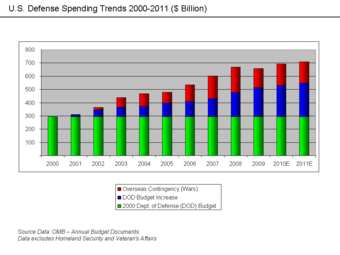
Trend chart
A trend chart shows changes in spending, prices, efficiency, or any other metric that management is interested in analyzing over time. This chart of U.S. defense spending from 2000–2011 shows that overall spending increased from $300 billion to $700 billion due to increases in both the Department of Defense (DOD) budget and overseas (war-related) spending.
Benchmarking
Benchmarking allows a manager to see how different aspects of a business (usually quality, time, and cost) are performing compared to national, regional, and industry standards. It also allows a manager to explore how the company is performing compared to competitors. In the process of benchmarking, management identifies the best firms in the industry, or in another industry where similar processes exist, and compares the results and processes of the target firms to management’s own results and processes. In this way, management learns how well the targets perform and, more importantly, the business processes that explain why these firms are successful.
Financial Projections
Managers can also use financial analysis as a management tool. When investing in a project or an acquisition of any kind, a manager will always want to know how quickly the investment will bring in a profit. For example, when a company invests in a new building, management will calculate how long it will take for the building to generate enough income to cover the upfront cost of the building and therefore start bringing in profits. This calculation is sometimes called a payback period. Payback period intuitively measures how long something takes to pay for itself. All else being equal, shorter payback periods are preferable to longer payback periods. This is often referred to as an NPV, or a net present value, where the company calculates the future value of the project in today’s dollars. It is critical to remember that a dollar today and a dollar tomorrow have a different value.
3.4.2: Operations-Management Tools
Six Sigma and Lean are two popular operations-management theories that help managers improve the efficiency of their production processes.
Learning Objective
Give examples of operations management tools that assist the organization in overseeing, designing and controlling production processes
Key Points
- The main tools of operations management come from two popular theories of organizing business: Six Sigma and Lean.
- Six Sigma relies on particular quality-management methods, such as statistical analytics, and creates a special infrastructure of employees within an organization (e.g., “Black Belts,” “Green Belts”) who are experts in these methods.
- Lean is a production theory that considers the expenditure of resources for any goal other than the creation of value for customers wasteful, and thus a good target for elimination.
- By leveraging operational paradigms constructed to deliberately capture value through maximizing efficiency, managers can lower costs for companies and prices for consumers.
Key Terms
- Lean
-
Lean is a production strategy focused on eliminating all unnecessary waste in production.
- Six Sigma
-
A process-improvement method that focuses on statistical methods to reduce the number of defects in a process.
Operations management is a type of management that oversees, designs, and controls a company’s production processes. This type of management is also tasked with redesigning business operations in the production of goods and/or services, if that is necessary. Operations managers are responsible for ensuring that business operations are efficient, both in terms of conserving resources and in terms of meeting customer requirements. They manage the process that converts inputs (materials, labor, and energy) into outputs (goods and services). In order to accomplish this task, managers utilize various tools, two of the most influential being Six Sigma and Lean.
Six Sigma
Six Sigma is a strategy designed to improve the quality of process outputs. The Six Sigma program accomplishes this by identifying and removing the causes of defects (errors) and by minimizing the variability present in manufacturing and business processes.
This strategy relies on particular quality-management methods, such as statistical analytics, and creates a special infrastructure of employees within an organization (e.g., “Black Belts,” “Green Belts”) who are experts in these methods. Each Six Sigma project in an organization follows a defined sequence of steps and has quantified financial targets such as reducing costs or increasing profits. Among the tools used in Six Sigma are process mapping, trending charts, calculations of potential defects, ratios, and statistics. Best practices for work within a team are also used.

Six Sigma
Six Sigma is a tool used by many managers when determining how to reduce the number of defects created by their processes.
Lean
Lean is similar to Six Sigma, but is slightly less focused on defect rate and more focused on eliminating the amount of waste and excessive steps in an operation. Lean is a production theory that considers the expenditure of resources for any goal other than the creation of value for the customer wasteful, and thus a target for elimination. Beginning from the perspective of the consumer of a product or service, “value” is defined as any action or process that a customer would be willing to pay for. Lean employs tools to evaluate production workflow and determine where there is waste. Examples of this waste would be excess motion, inventory, and overproduction.
Examples of Six Sigma and Lean
In many ways, Lean manufacturing and Six Sigma is reminiscent of Henry Ford and systematic process improvements. The overarching theme is simply to minimize time expenditures on behalf of employees and maximize output with the same amount of input. Toyota (and the concept of kaizen) is a fantastic example of Lean manufacturing and what is called just-in-time (JIT) inventory management. Toyota became famous in manufacturing for timing every specific element of the manufacturing process to ensure that minimal warehousing was required, delivering each new add-on component at precisely the time it would be needed and in exactly the location it would be installed. This created a process flow that minimized space usage (lowering costs), optimized timing, and created widespread consistency of operational flow.
Lean and Six Sigma are the two main tools for managers in operations management. Both of these operational strategies offer managers an extensive toolbox with which to analyze how efficiently their production is running. These tools analyze workflow, evaluate the presence and cause of waste, and decrease defects in products or services, all of which make a company more efficient.
3.4.3: The Systems Viewpoint
Systems thinking is an approach to problem solving that considers the overall system instead of focusing on specific parts of a system.
Learning Objective
Define the systems view as it applies to business strategies and overall organizational control
Key Points
- Systems thinking is an approach to problem solving that views problems as part of an overall system. This is opposed to problem-solving strategies that only focus on specific parts or outcomes of a problem.
- Systems thinking approaches problems as a set of habits or practices within a framework. It is based on the belief that the component parts of a system are best understood in the context of their relationships with each other rather than in isolation.
- Systems thinking is opposed to fragmented thinking, which involves thinking about specific problems without considering the context, environment, and effects of similar problems.
Key Term
- fragmented thinking
-
Thinking about problems as isolated events instead of considering problems as resulting from a system as a whole.
Systems thinking is the process of understanding how people and situations influence one another within a closed system. In nature, air, water, movement, plants, and animals interact with one another and survive or perish in relationship with each other. In business, management also involves systems thinking.
Organizational Systems
Organizational systems consist of people, structures, and processes working together to make an organization healthy or unhealthy. The end product of effective systems management is synergy, in which the end product has more value than the individual sum of its parts. Systems generally contain the following aspects:
- Inputs (e.g., people, time, energy, information)
- Processes or reactions (e.g., tools, software, analyses)
- Outputs (e.g., products, reports, plans)
- Feedback mechanisms (e.g., information, reports)
Problem Solving
When problem-solving, advocates of systems thinking must consider specific problems within an overall system rather than reacting to specific issues or specific outcomes. In systems thinking, problems are conceptualized as a set of habits or practices that exist within a framework. Practitioners of systems thinking believe that the component parts of a system can best be understood, and best analyzed, in the context of their relationships with other parts of a system .

Systems thinking
Focus on the interaction of isolated problems with one another: just as separate gears work with each other, problems in one area can effect other areas in a system as well.
This method is opposed to a reductive framework that attempts to focus closely on a single problem. In this type of fragmented thinking, problems are addressed without considering the context, environment, or the impact of similar problems. Fragmented thinking often results in solutions that cannot be applied to multiple situations and are unlikely to remain relevant over time. This means management will be putting out more fires because the root problem is unresolved.
Here is an example of systems thinking: say that a single department, Human Resources, is beset with problems in workflow and efficiency. A manager who uses systems thinking to fix this problem looks at Human Resources in the context of all of the workflow in the company to see whether the “Human Resources problem” could actually be a company-wide issue. Only a systems-thinking approach can lead to this realization because systems thinking provides insight into how problems that manifest in a specific location can spring from distant, seemingly unrelated locations. This helps managers get an accurate understanding of the problem and facilitates a superior response to the problem.
Example
Here is an example of systems thinking: say that a single department, Human Resources, is beset with problems in workflow and efficiency. A manager who uses systems thinking to fix this problem looks at Human Resources in the context of all of the workflow in the company to see whether the “Human Resources problem” could actually be a company-wide issue. Only a systems-thinking approach can lead to this realization because systems thinking provides insight into how problems that manifest in a specific location can spring from distant, seemingly unrelated locations. This helps managers get an accurate understanding of the problem and facilitates a superior response to the problem.
3.4.4: The Contingency Viewpoint
The contingency viewpoint of management proposes that there is no standard for management; instead, management depends on the situation.
Learning Objective
Recognize the potential flexibility and value that can be captured through considering contingencies and alternatives from a managerial perspective
Key Points
- The contingency viewpoint is a more recent development in organizational theory that attempts to integrate a variety of management approaches, proposing that there is no one best way to organize a corporation or lead a company.
- Debating which one of the previous approaches to management is the “best” approach is irrelevant in contingency theory, since the heart of the contingency approach is that there is no “one best way” for managing and leading an organization.
- The contingency viewpoint focuses on management’s ability to achieve alignments and good fits between employees and circumstances by considering multiple solutions to determine the best one for each particular problem.
- The focal point, and modern relevance, of this perspective is the concept of adaptability. Technology and globalization evolve the business environment so rapidly that adaptable strategies are more appropriate than static ones, making contingencies key to success.
Key Term
- Contingency Viewpoint
-
A theory of management that proposes that there is no standard for management practice, instead it should depend on the situation.
The contingency viewpoint is a more recent development of organizational theory that attempts to integrate a variety of management approaches by proposing that there is no one best way to organize a corporation or lead a company. Instead, the optimal course of action is contingent or dependent upon the specific internal and external situation management may find itself in.
Perspective on Previous Theories
The contingency approach claims that past theories, such as Max Weber’s bureaucracy theory of management and Taylor’s scientific management, are no longer practiced because they fail to recognize that management style and organizational structure are influenced by various aspects of the environment, known as contingency factors. Debating which one of the previous approaches to management is the “best” approach is irrelevant in contingency theory, since the heart of the contingency approach is that there is no “one best way” for managing and leading an organization.

Possibilities
The basic premise behind contingency theory is that there are limitless possibilities that companies must be prepared to adapt to strategically.
An Outline of Contingency Theory
By its nature, contingency theory avoids static rules. There are, however, common contingencies that businesses must react to, including technology, competition, governments, unions, consumer interest groups, new markets and consumers, and economic factors. Fred Fiedler takes this a step further to identify three leadership styles and empirical situation measurements to assess the degree of favorability a given contingency offers:
- The leader-member relationship, which is the most important variable in determining the situation’s favorableness.
- The degree of task structure, which is the second most important input into the favorableness of the situation.
- The leader’s position power obtained through formal authority: this is the third most important dimension of the situation.
In other words, leadership needs to ensure that it is able to assess a situation, determine the task structure, and obtain a position of formal authority in order to be able to adequately manage a contingency situation.
An example of the contingency viewpoint in action is a manager facing a situation with an employee who regularly shows up late to work. A manager could have a written protocol for this situation in which there is only one option: give the employee notice. Under the contingency viewpoint, however, the manager may decide to better understand the situation by talking to the employee about why s/he is late to work and then deciding on the most effective and appropriate course of action. The value in this lies in the information the manager acquires about the employee: maybe there are extenuating circumstances that can be relatively easy to work around. In this case, the contingency approach allows the employee to keep her/his job and saves the manager from going through the time and trouble to dismiss one employee and hire another.
A leader’s ability to manage under the contingency viewpoint depends largely on the nature of the environment and how the organization relates to the environment. Therefore, the organizational structure is a major component of the approach that management may take in resolving problems under contingency theory.
3.4.5: Quality Control and Assurance
Quality assurance and quality control are intended to ensure that products are created with the fewest number of defects possible.
Learning Objective
Discuss quality control (QC) and quality assurance (QA) as integral components of an effective organizational management structure
Key Points
- Quality assurance (QA) refers to planned and systematic activities implemented in a quality system to fulfill the quality requirements for a product or service.
- Quality control (QC) is a process by which products are tested to uncover defects and the results are reported to management, which makes the decision to allow or deny product release.
- Quality control and quality assurance work together to make sure that a company’s products have the lowest possible error rate.
- As global markets expand, and as outsourcing becomes common practice, QC and QA are increasingly important strategic initiatives. When companies do not control their manufacturing process, they must invest in controlling the quality of their vendors.
Key Term
- Failure testing
-
Failure testing involves determining the point of stress level in which a product will fail.
Quality assurance and quality control are two methods of planning and implementing structured methods in a work process to ensure that products are created with the highest possible quality and with the smallest number of defects and problems.
Quality Assurance
Quality assurance (QA) refers to the planned and systematic activities implemented in a quality system to fulfill the quality requirements for a product or service It is a systematic measurement compared to a set standard, with process monitoring used to prevent errors. This can be contrasted with quality control, which is focused on process outputs. Two key principles of QA are:
- Fit for purpose: The product should be suitable for its intended purpose.
- Right the first time: Mistakes should be eliminated.
QA includes managing the quality of raw materials, assemblies, products, components, services related to production, management processes, production processes, and inspection processes. The critical takeaway here is that QA equates to process observations.
Quality assurance is measured through failure testing and statistical control. Failure testing determines the stress levels under which a product will fail by exposing it to unanticipated stresses, like intense vibration, temperature, and humidity. Stress testing uncovers problems that can be fixed with simple changes to improve the product. Statistical controls ensure that an organization is producing quality products at the lowest possible defect rate. Many organizations use Six Sigma levels of quality, so the likelihood of an unexpected failure is less than four in one million.

Assembly line and quality control
Many processes, such as assembly lines, help ensure quality assurance and control by streamlining the production process.
Quality Control
Quality control (QC) is the process of testing finished products to uncover defects and reporting the results to management, which makes the decision to allow or deny product release. It differs from quality assurance, which attempts to improve and stabilize a product, and eliminate any flaws, during production.
Controls also include product inspection: every product is examined visually before the product is sold into the external market. Inspectors are provided with lists and descriptions of unacceptable product defects, such as cracks or surface blemishes. Efficient quality control depends on top-notch visual examination of products, employee training, and organizational culture.
Quality control and quality assurance work together to make sure that companies produce products that have the lowest possible error rate, so there will be fewer customer complaints and no need to rework the product in the future.
Outsourcing
Due to the high degree of vendor dependency, many corporations find their manufacturing processes are conducted outside of their organization. This can lead to difficulties in maintaining process quality. In this situation, a corporation needs to invest in QC professionals to maintain organizational standards. The primary takeaway here is that QC is not simply an internal concern for many businesses, but also an external vendor selection criteria.
3.4.6: Evidence-Based Management
Evidence-based management emphasizes the importance of managers using the scientific method to make decisions.
Learning Objective
Discuss the modern organizational theory perspective on utilizing evidence-based strategies, as is common in many science disciplines, to make business decisions
Key Points
- Evidence-based management is rooted in evidence-based medicine, a movement to apply the scientific method to medical practice. Evidence-based management is an emerging movement to explicitly use current best practices in managerial decision-making.
- Evidence-based management bases managerial decisions and organizational practices on the best available scientific evidence.
- While there is a rich body of academic literature pertaining to tried-and-true managerial strategies, real-world application of such resources is relatively rare.
- Promoting evidence-based management is challenging because it can conflict with traditional definitions and expectations of management.
- Little shared terminology exists between managers of different companies, which makes it difficult for managers to hold discussions on evidence-based practices. The adoption of evidence-based practices is likely to be organization-specific instead of happening across organizations.
Key Term
- terminology
-
The set of terms actually used in any business, art, science, or the like; nomenclature; technical terms; such as, the terminology of chemistry.
Evidence-based management (EBMgt or EBM) is an emerging movement that explicitly uses current best practices in managerial decision-making. Evidence-based management is rooted in evidence-based medicine, which is the rigorous statistical and experimental process that new pharmaceuticals go through prior to being deemed safe to use. This results in treatments that are the maximally effective and safe for patients. Applying this to business simply means utilizing the scientific method, which integrates rigorous and objective hypothesis testing, in order to identify best practices.

Research and Evidence-Based Management
Evidence-Based Management is modeled after Evidence-Based Medicine, which emphasizes the importance of scientific research in decision-making.
The Scientific Method
Evidence-based management bases managerial decisions and organizational practices on the best available scientific evidence. Practicing EBMgt requires managers to collect data, run tests, generate hypotheses, and objectively interpret the findings to create an accurate depiction of the efficacy of a given managerial style or decision. This is quite challenging, because management is much less tangible and measurable than many other scientific disciplines.
An example of EBMgt in practice could be a group of managers in an organization trying to determine how to improve job satisfaction. They could conduct a comprehensive and objective (therefore blind) survey across a large number of organizations, collecting enough data on the organizational reimbursements for employees, employee satisfaction, and company cultures to determine if a positive company culture is more relevant than salary to job satisfaction. After collecting n number of responses, this data could be assessed statically for a confidence interval, revealing the conclusion to be either significant or insignificant to future management decisions.
Integration with Organizations
While there is a rich body of academic literature pertaining to tested and true managerial strategies, real-world application of such resources is relatively rare. MBAs and degree holders in business have some exposure to this literature, but rarely move it from the theoretical realm to actual practice. Motivating real-life applications of these studies for management could prove advantageous for companies looking to improve their managerial effectiveness.
An important component of evidence-based management is helping managers understand the importance of backing up decisions with sound scientific reasoning. Unfortunately little shared language or terminology exists between managers, which makes it difficult for managers to hold discussions of evidence-based practices. For this reason, the adoption of evidence-based practices is likely to be organization-specific, where leaders take the initiative to build an evidence-based internal culture.
3.5: Evolving Organizations
3.5.1: Knowledge Management and Behavior Modification
Knowledge management and behavior modification are tactics employers use to ensure organizational growth and adaptability.
Learning Objective
Compare and contrast the acquisition of knowledge and the modification of behavior as internally evolving organizational components
Key Points
- Knowledge management is an organizational concept that takes the best knowledge from individual employees and organizes it into a functional learning and education system that all employees can learn from.
- Knowledge management is usually implemented by a company’s information technology department via electronic collection of specific components of employee expertise, creation of online learning modules, and redistribution of the modules to the whole company.
- Behavioral modification includes the alteration of an individual’s behavior through data collection and positive/negative reinforcement.
- In an organization, behavior modification is typically studied to examine how employees perceive their performance in relation to rewards. At a high level, it is used to develop strategies for improving performance behavior.
Key Term
- Knowledge management
-
Used in organizations to collect employee’s specialized knowledge and organize, redistribute, and share with the company.
Knowledge management (KM), and the modification of behavior through utilizing organizational knowledge, is central to an organization’s ability to grow and adapt. The value of knowledge management from the perspective of the organization is its ability to help employees learn and improve their skills, allowing the organization itself to evolve and achieve higher efficiency. Knowledge is an intangible resource which organizations can concretize by documenting experience over time. This helps them to avoid repeating mistakes and to improve current strategies.
Knowledge Management
Knowledge management is the range of strategies and practices used by an organization to identify, create, represent, distribute, and enable the adoption of employee insights and experiences. These insights and experiences constitute the company’s “knowledge,” either embodied in individuals or embedded in organizations as processes or practices. KM includes courses taught in the fields of business administration, information systems, management, and library and information sciences.
More recently, other fields have started contributing to KM research, including information and media, computer science, public health, and public policy. Knowledge management also focuses on organizational objectives such as improved performance, competitive advantage, innovation, and continuous improvement. KM is similar to organizational learning but distinguishes itself because it focuses more on knowledge as a strategic asset of a company’s employees. It encourages the sharing of knowledge to further the company’s success.
Many organizations include resources dedicated to internal knowledge management efforts in their business strategy, information technology, or human resource management departments. Consulting companies are also sometimes hired to provide advice about knowledge management. Knowledge management in a company is sometimes seen as an organizational concept that takes the best knowledge from individual employees and organizes it into functional learning and education systems that all employees can learn from. The company’s information technology department can make this happen by electronically collecting specific components of an employee’s knowledge expertise, creating an online learning module, and redistributing it to the company.
For example, an employee who is particularly knowledgeable about a certain computer system. This employee may be asked to write a training manual or presentation about this computer system which is then distributed to the company so that others can also benefit from that individual’s knowledge. Knowledge-sharing is the most important component of knowledge management and is essential to helping an organization evolve and grow.
Behavior Modification
Behavior modification was first introduced in psychology as a collection of behavioral change techniques to increase or decrease the frequency of behaviors. In psychology, behavioral modification was made popular by B. F. Skinner, who analyzed the triggers and rewards for certain behaviors in a series of experiments with animals. Behavioral modification includes altering an individual’s behavior through positive and negative reinforcement.
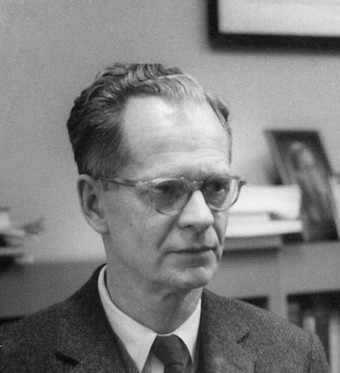
B.F. Skinner
B.F. Skinner introduced the study of behavior modification, focusing on how animals and humans react to reward and punishment. His theories are still used in behavior modification today.
Behavior modification in an organization is typically studied to examine how employees perceive their performance in relation to rewards. The process of behavioral modification in the workplace focuses on identifying the frequency of certain performance-related behavior, as well as determining what started or triggered that specific behavior. Once the trigger is identified, management can determine if it wants to develop a different trigger to change the employee’s performance or if it should sustain the current performance through rewards and appraisal.
Behavioral modification is generally used on a broader scale to determine how best to develop employee performance to move an organization in the desired direction. Knowledge management can help with this by providing employees with adequate training and skills and making sure that they know that they are valuable members of the organization worth investing in and empowering. Training employees and improving their knowledge, skills, and behavioral approaches to work helps an organization to evolve and improve.
Example
An example of knowledge management would involve an employee who is particularly knowledgeable about a certain computer system. This employee may be asked to write a training manual or presentation about this computer system, which is then distributed to the company so that others can also benefit from that individual’s knowledge.
3.5.2: Accelerated Change and Adaptation
Change management facilitates employee adaptation to organizational change.
Learning Objective
Identify the role of change management with the larger context of organizational theory
Key Points
- Change is essential to organizational growth and development. But employees can be uncomfortable with change, particularly when it affects their work on a daily basis.
- Sometimes an organization faces accelerated change, from attempts to change its overall mission, for example, or to implement a disruptive technology. In this situation it is important for employees to be able to adapt quickly.
- Quick adaptation to change is facilitated through change management strategies such as communication, employee alignment with expectations, training, and transparency of management.
Key Term
- change management
-
Change management attempts to use strategies such as communication and training to help employees become more comfortable with organizational changes.
Managing Change and Adaptation
Change is essential to organizational growth and development. But employees don’t always embrace change, particularly when it upsets routines and/or the status quo. Employees can view change as a threat if it impacts their daily tasks, training, or possibly their job. Change management is an approach to shifting and transitioning individuals, teams, and organizations from a current state to a desired future state. It is an organizational process aimed at helping change stakeholders to accept and embrace changes in their business environment.
Drivers of rapid adaptation are numerous, but one of the most relevant to modern organizations is the advent of new technology. When the smartphone was introduced and became popular, all companies in the phone industry had to react rapidly to switch their operational focus to smart phones, data plans, app stores, and multiple device integration. Companies that could not react and adapt quickly enough to the disruptive technology were left in the dust.
Sometimes an organization faces accelerated change when it is attempting to change its overall mission and refocus its vision. In the recent recession, this occurred within a number of organizations that thought that the best way to survive was to re-brand or reorganize their business strategy as a whole. Changing a company’s brand or overarching strategy (i.e., differentiation to low-cost or vice versa) is a massive overhaul that will undoubtedly upset a number of people internally and externally. Responsible change is a complex process.
Organizational Change and Employees
Major changes to an organization will force employees to adapt. Employees may not approve of the change, but they will be required to adapt to it if they want to keep their jobs. This is likely to create tension between what the employees want and what is occurring in the organization. Change management helps employees adapt to accelerated organizational change by attempting to eliminate the tension between employees’ resistance to and suspicions about change and the organization’s new direction.
Change management uses basic structure and tools to control an organizational change effort; these primarily revolve around ensuring that all stakeholders are aware of what’s going on and involving them in the strategic process. Managerial transparency about what is happening and why is critical to employee buy-in. Communicating effectively and comprehensively and hearing out employee fears, criticisms, and suggestions are integral to ensuring that everyone is on the same page. When changing the organization is required to remain profitable, employees will understand that they must pitch in to maintain the relevancy of their job.
3.5.3: The Role of the Manager in an Evolving Organization
Managers play a number of roles in evolving organizations, including leader, negotiator, figurehead, liaison, and communicator.
Learning Objective
Break down the various and critical roles a leader must play in the transitional process from an organization perspective
Key Points
- A manager needs to be a good leader. While a manager organizes and plans, s/he must also inspire employees with a vision for the organization.
- A manager needs to be an effective negotiator. When organizations are developing or undergoing change, the manager is often required to negotiate with competitors, contractors, suppliers, and employees.
- A manager must be a good figurehead who reinforces the mission and vision of an organization to employees, customers, and other stakeholders.
- A manager needs to be an effective communicator and liaison between employees, customers, and other managers of the organization.
Key Term
- leader
-
A leader is thought to differ from a manager in that a leader’s intention is to inspire and motivate while a manager’s role is focused more on organization and planning.
Managers play an integral part in an organization’s growth and evolution. Organizational growth is a complex process, particularly in larger organizations with more inertia. Organizations are essentially a compilation of moving parts: motivating each individual, with her/his unique talents and motivation, to change direction simultaneously (and in the same direction) is extremely challenging, and requires highly effective managers with highly developed communication skills.
Managers must do more than accept change: they must facilitate the evolutionary process. In these situations, organizations need a manager who can fulfill several roles, including leader, negotiator, figurehead, and communicator. In each of these roles, the manager’s goal is to help employees through the change with the least possible number of conflicts and issues.
The Role of a Manager during Organizational Change
Leader
To effectively implement change, a manager needs to be a good leader. The manager must organize and plan the change and use leadership skills to inspire employees to embrace it. This is a complex and intangible skill, one which incorporates each of the roles listed below as well. Leadership is a broad term that incorporates communicating and inspiring those around you to embrace a perspective.
Negotiator
A negotiator is similar to a leader. When organizations are developing or undergoing change, the manager is often required to negotiate clearly and steadfastly with competitors, contractors, suppliers, and employees. A manager needs to be able to negotiate with all of these parties in a way that effectively serves the best interests of the organization.
Figurehead
A manager also needs to act as a figurehead of the organization. Upper management in particular is responsible for creating and reinforcing delivery of the mission and vision of an organization to employees, customers, and other stakeholders. Employees in particular must understand where the organization is headed and what its ultimate goals are. A manager-figurehead can come to symbolize the organization as a whole for customers. The manager who builds a positive rapport with both customers and employees creates a positive association of her/himself with the organization at large.
Liaison and Communicator
When managers effectively communicate their vision for the organization, employees are more likely to engage with their work and exert themselves to further the organizational mission. Communication is at the core of managing change effectively. Transparency and empathy are integral to making employees aware of and comfortable with the changes taking place. Managers in an evolving organization must stay in constant contact with their direct reports to ensure that everything is running smoothly and that all stakeholders are educated and on board.
